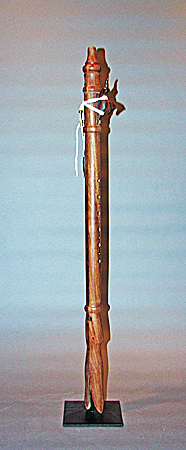
Owner: HWMC
Catalog#: NA-AEWF-07
Edge-blown Flutes
Ho-Chuck Nation 'Flute' by Ira Funmaker
Ho-Chunk Nation in Wisconsin
Northern Great Plains / Maker: Ira Funmaker
Wood, turquoise, leather
Late 20th century
Length: 29 in
Aerophone – Wind Instrument Proper – Edge-blown Flutes
Signed: Ira Funmaker
A one-piece hand carved Ho-Chuck Nation (Winnebago) flute signed by maker Ira Funmaker. It is carved from Guatemalan Rosewood with the carving of a horse at the air chamber tied with buckskin. Turquoise inlay is positioned between each of the six finger holes and at the end is a carved bird’s head and beak. Ira Funmaker is from the Ho-Chunk Nation in Wisconsin and is well known for creating unique flutes from exotic woods. He indicated that he learned the art of flute making from a medicine man.
The Winnebago, a tribe of Native Americans are a Siouan-speaking people. The actual name of the tribe is Ho-Chunk or Hoocagra, and their people often refer to themselves as Hochungr – ‘People of the Parent Speech.’ The name ‘Winnebago’ was given to them by neighboring tribes. Historically, their territory spans from parts of Wisconsin, Minnesota, Iowa, and Illinois. Some historians believe the Winnebago tribes are responsible for several of the large man-made mounds in the Wisconsin area. These massive effigies in the shape of birds and other animals were built entirely by hand and it is thought that they were used as places of worship as well as burial sites.
Today, the Winnebago people are split into two separate reservations. The original reservation in Nebraska still stands as the Winnebago Tribe of Nebraska, in the city that is named after them. Adopting their original name of Ho-Chunk, the other reservation is located in the tribe’s homeland of Wisconsin, near the city of Black River Falls.
This is possibly a courting flute, which were used principally by Woodlands tribes, Southwestern tribes, and tribes from the Southern and Northern Plains as an integral part of traditional music. They were used as both means of transmitting signals in the night, and as a means by which a young man could communicate his love. Flute making is never a static form, as seen here with the addition of turquoise.
Reference: Winnebago Tribe and History; Winnebago Tribe of Nebraska – Wikipedia
